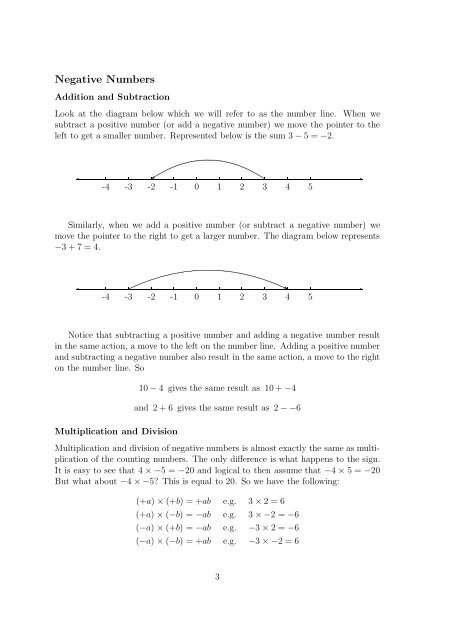Review of Basic Mathematics
Review of Basic Mathematics
Review of Basic Mathematics
Create successful ePaper yourself
Turn your PDF publications into a flip-book with our unique Google optimized e-Paper software.
Negative Numbers<br />
Addition and Subtraction<br />
Look at the diagram below which we will refer to as the number line. When we<br />
subtract a positive number (or add a negative number) we move the pointer to the<br />
left to get a smaller number. Represented below is the sum 3 − 5=−2.<br />
✛<br />
.<br />
...<br />
..<br />
✲<br />
-4 -3 -2 -1 0 1 2 3 4 5<br />
. .<br />
✙<br />
Similarly, when we add a positive number (or subtract a negative number) we<br />
move the pointer to the right to get a larger number. The diagram below represents<br />
−3+7=4.<br />
.<br />
.<br />
.<br />
..<br />
-4 -3 -2 -1 0 1 2 3 4 5<br />
✛ ❥<br />
✲<br />
Notice that subtracting a positive number and adding a negative number result<br />
in the same action, a move to the left on the number line. Adding a positive number<br />
and subtracting a negative number also result in the same action, a move to the right<br />
on the number line. So<br />
Multiplication and Division<br />
10 − 4 gives the same result as 10 + −4<br />
and 2 + 6 gives the same result as 2 −−6<br />
Multiplication and division <strong>of</strong> negative numbers is almost exactly the same as multiplication<br />
<strong>of</strong> the counting numbers. The only difference is what happens to the sign.<br />
It is easy to see that 4 ×−5=−20 and logical to then assume that −4 × 5=−20<br />
Butwhatabout−4×−5? This is equal to 20. So we have the following:<br />
(+a) × (+b) =+ab e.g. 3 × 2=6<br />
(+a) × (−b) =−ab e.g. 3 ×−2=−6<br />
(−a)×(+b) =−ab e.g. −3 × 2=−6<br />
(−a)×(−b)=+ab e.g. −3 ×−2=6<br />
3
















